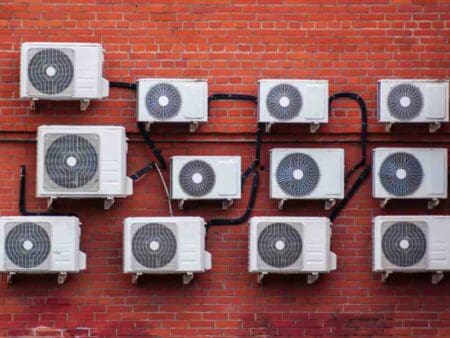
With France in the lead, Europe’s buildings sector is avoiding more greenhouse gases than ever before thanks to record growth in heat pump sales in 2022, according to the 2023 European heat pumps market report from the European Heat Pump Association.
According to the report, published by the European Heat Pump Association (EHPA), European heat pumps sales grew by +38.9% in 2022. With 3 million units sold across Europe, the Association states this is a new sales record.
France, which yet again saw strong heat pump growth last year, was found by the report to be leading the way in terms of avoided greenhouse gas emissions through heat pumps, at over 16Mt. It is followed some way behind by Germany and Italy at over 5Mt avoided each.
Still not on track
Although the figures are promising, more is yet needed, states the Association.
In a press release announcing the report, they stated:
“If things were to stay this way, the buildings sector would be off track to decarbonise heating and cooling by 2050, as the EU climate law requires. This is because the playing field is still tipped massively in favour of fossil fuels, in terms of subsidies and taxation.
“However, the issue is very likely to be addressed soon by the European Commission in their upcoming EU Heat Pumps Action Plan, which should help make the situation fairer for clean solutions.”
Jozefien Vanbecelaere, head of EU affairs at EHPA, added that “heat pumps have a leading role to play to reach net zero emissions, but to bring them centre stage governments must give clear policy signals. They can do this by addressing distorted pricing which favours gas over electricity and supporting the EU Commission’s proposed phase out of standalone fossil fuel boilers.”
Have you read:
EUSEW: Research report finds heat pumps booming
Tech Trends: Acoustic core heat pumps
European heat pumps figures
With approximately 120 million residential buildings in Europe, the report finds the heat pump market share in the building stock at over 16%.
According to the report, all heat pump markets across Europe experienced substantial growth. Specifically:
• The strongest relative gains were achieved in Belgium (+118.0%), Poland (+112.0%) and the Czech Republic (+105.9%).
• 87% of the European market volume was sold in only ten countries. The five biggest European heat pumps markets in 2022 were France (621,776 units sold; +15.8% growth vs. 2022), Italy (513,535; +35.2%), Germany (275,697; +59.0%), Sweden (215,373; +61.3%), and Poland (207,992; +112.0%).
• The biggest absolute gains were achieved in Italy (133,564), Poland (109,890), Germany (102,310), France (84,665), Sweden (81,875) and Finland (66,984).
• The Nordic countries show the biggest market penetration for heat pumps in the building stock and also experience significant shares of the technology in the renovation sector.
• Sweden, Norway, Denmark and Finland grew by 40,092 units, although figures for the Swedish market in the report do not include the growth in air-air heat pumps.
• While Finland’s market is maturing, it revealed a significant growth perspective for Europe. If all countries had the same market penetration as Finland, they state, the annual sales number of heat pumps in Europe would be more than seven times bigger than today’s, resulting in 15 million units sold per year and – if maintained until 2030 – reaching a stock of 106 million units in that year.
• In aggregated terms, 19.79 million heat pump units were installed since 1996. This amounts to an installed thermal capacity of 173.6GW.
• All installed heat pumps produce 325TWh of useful energy, 205.2TWh of which being renewable. Their use saved 262.6TWh of final and 117.6TWh of primary energy.
For policymakers, states the report, the findings mark a good forecast, as it reveals significant untapped potential to reduce Europe’s energy demand for heating, cooling and hot water production.
However, they add that achieving it by 2030 would require an annual 21% growth rate and a tremendous effort with regards to framework conditions, efficiency requirements for buildings, upskilling of installers and planner/architect qualifications as well as the development of flanking measures.

Over in the UK
Responding to the release of the EHPA’s report was The Heat Pump Association, which are members of the EHPA, who commented on the report and its signals for the market in the UK.
Stated the Association: “The European Heat Pump Association’s latest market report showcases the positive impact heat pumps are having across Europe to mitigate emissions and grow European economies. We welcome these figures and believe the UK can afford to be equally ambitious provided the Government takes swift and decisive action to support the market.”
According to the Association, the UK is showing significant progress in its heat pump rollout, with the first half of 2023 projecting a sales growth of 10%.
However, they add that the country is still falling behind, “with one of the lowest heat pump penetration rates across Europe despite high forecasted growth.”
The Association related this back to the correlation between decreasing ratio of gas to electricity prices and increased heat pump sales; “it is concerning that the UK has one of the highest ratios of electricity to gas prices out of 27 countries analysed in the report.”
Charlotte Lee, chief executive of the Heat Pump Association, also commented: ” We believe the UK Government’s projected deployment target of 600,000 heat pumps installations per year by 2028 remains achievable provided it moves swiftly and decisively to introduce the Future Homes Standard, provide early clarity of a date for the full phase out of 100% fossil fuel boilers, and takes steps to reduce the price of electricity.”
According to the World Green Building Council, buildings are responsible for 39% of global energy-related carbon emissions; 28% from operational emissions from energy needed to heat, cool and power them.








